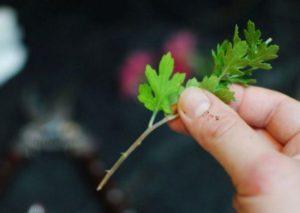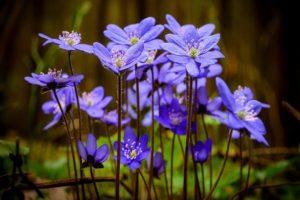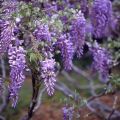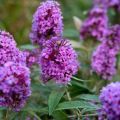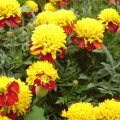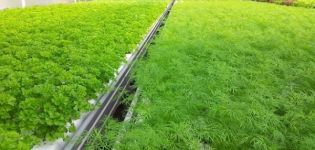Description and characteristics of the Blue moon wisteria variety, planting and care
Blue moon wisteria is a thermophilic woody plant that forms lush inflorescences and adorns the garden. It is grown both outdoors and in appropriately sized pots. The tree is not picky to care for, it tolerates drought and severe frosts well. Possesses persistent immunity.
Description and characteristics of wisteria Blue moon
A woody plant, it belongs to lianas, the height of which reaches 6-7 meters. The flowers are purple-blue in color. Wisteria inflorescences are collected in bunches of 15-20 flowers. Leaves are dark green, smooth, shiny, pinnate. Each sheet has an elongated shape, a pointed end and a wavy edging, up to 35 centimeters long. After flowering, brown fruits are formed.
The plant has a powerful root system, capable of feeding on water from deep soil layers. It is the most frost-resistant type of vines.
Main positive and negative aspects
The positive aspects include:
- ease of growing;
- high immunity;
- winter hardiness;
- drought resistance;
- beauty of flowers;
The negative aspects include the large size of the plant. If it is not possible to keep it in the fresh air all year round, then transporting such a plant will require effort.
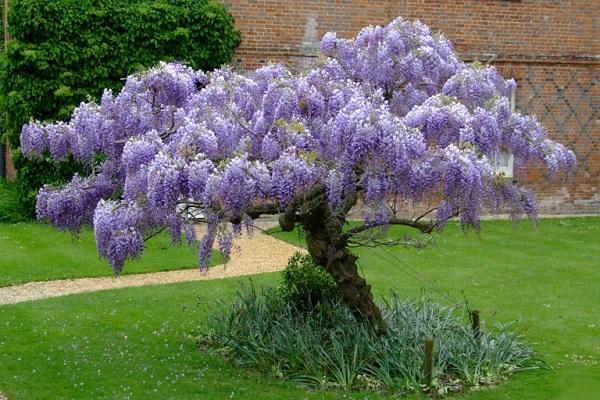
How to grow?
Landing time and place
For growing wisteria, choose a place with good access to sunlight. For improved flowering, it is recommended to create a 12-hour daylight hours. The soil should be loose, well-aerated without excess moisture. Drainage is laid at the landing site.
Important! To retain moisture at the roots of the tree, sprinkle the area around the trunk with chopped grass without seeds.
The choice of planting material
Young seedlings are chosen. The roots of the plant are carefully examined so that there is no rot and other damage. The branches are dense, the stems are elastic. If pruning of the branches of a seedling is noticed, then it may be sick. Branches and stems must be clean without uncharacteristic stains and mechanical damage.
Wisterias are also grown from seeds. But such a tree will bloom only after three years. Seeds and seedlings are sold in specialized agricultural stores.
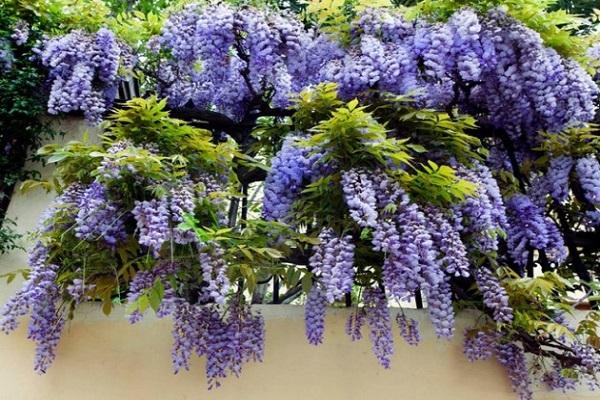
Planting process
Wisteria is planted in containers or open ground. For planting in a pot, produce as follows:
- Choose a pot with a volume of 40 liters or more, with a drainage hole and a stand.
- A small layer of soil is poured onto the bottom of the pot.
- Then a drainage from coconut threads is formed.
- Warm water is added.
- A seedling is placed, after having spread the roots.
- Fall asleep layer by layer with earth, tamping each layer.
- Sprinkle with warm water.
Important! When using ready-made soil purchased from a store, drainage does not need to be formed.
This method is used when it is impossible to store the plant in winter in the open field. In the summer, it is recommended to plant it in fresh air. Also, in this form, the tree is inconvenient to transport.
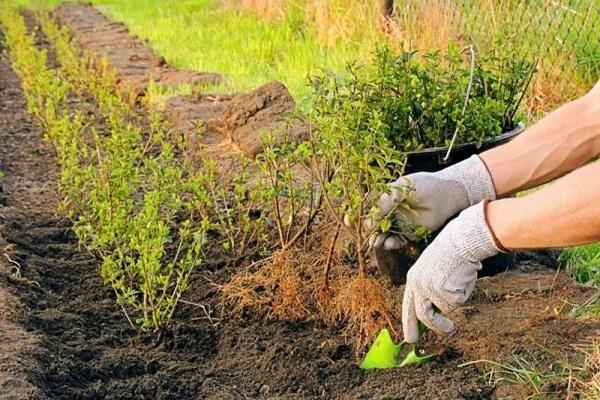
Planted in open ground as follows:
- A hole is prepared, 20-25 centimeters deep, 40 by 40 centimeters wide.
- Fill the pit with humus.
- The earth is mixed with sand.
- The seedling is placed in the hole.
- Sprinkle with earth layer by layer, tamping each layer.
- Sprinkle with warm water.
- Cut stalks of grass without seeds are poured on top around the trunk.
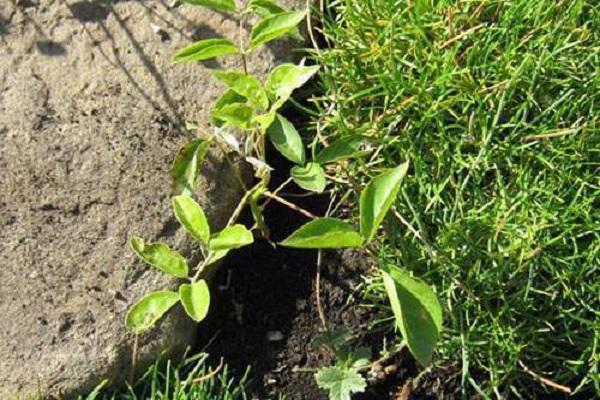
The nuances of care
For lush flowering, certain care rules must be followed. Carry out subcrustations, monitor watering, cut, cover the roots for the winter.
Fertilizing and feeding
Top dressing is not carried out on fertile soils. In other cases, fertilize with phosphorus, potassium, lain manure. Mineral fertilizers are diluted in water and applied during the period of ovary formation every three days. Water the area around the trunk. Fresh manure cannot be used, it contains a lot of nitrogen, which will destroy the plant.
With an excess of fertilizers, wisteria macrostachia Blue Moon develops poorly and dies, therefore, feeding should be carried out strictly according to the scheme.
Transfer
Wisteria does not tolerate transplants very well. However, if it becomes necessary to change its place of growth, then the tree is dug up and moved to new soil with a large clod of earth. Long shoots are cut before transplanting.
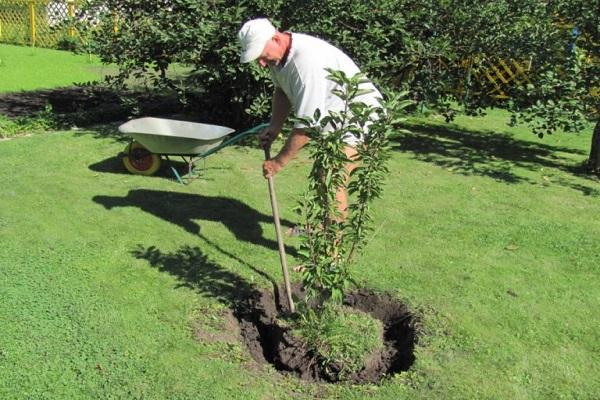
Watering
The plant does not bloom well with an excess of moisture in the soil. Therefore, watering should not be frequent. Enough once a week in a volume of 10 liters per bush. If the ground is wet or after rain, watering is canceled. After flowering, watering is completely canceled. When grown in a pot in winter, watered only in very dry soil.
Flowering and preparing for winter
Flowering begins in late May and lasts about a month. Flowers are small, collected in large inflorescences of 15-20 pieces. Has a large size, up to 35 centimeters. When grown in warm climates, flowering may recur in the fall. Withered flowers are cut off so that the plant does not waste energy on the formation of fruits, but directs them to the development of flowers.
For the winter, the perivolate circle of the tree is insulated with moss. This will help keep the plant's root system safe. If the wisteria is young and its branches have not grown stronger, then they are wrapped in warm fabrics. Warming is carried out at the onset of the first autumn frost. Adult plants are highly frost-resistant and can tolerate temperatures of -40 ° C.

Pruning
The manipulation is carried out to form a beautiful crown of the tree. In the first growing season, cut off all parts of the plant outside the 5 main axillary buds. Every spring, the branches are thinned, all damaged and dried shoots are removed. This improves the abundance of flowering and the size of the flowers.
Diseases and pests
Wisteria Blue moon is a poisonous plant. Diseases and pests rarely affect her. Most often, insect infestation and attack occurs if the bush is damaged. Chlorosis is observed among diseases. The leaves turn yellow and fall off. This indicates a too acidic environment in the soil. Fertilization is carried out with fertilizer with iron chloride, this will help to change the soil environment to a more favorable one. The plant recovers quickly.
Insects affecting wisteria:
- Clover mite. The leaves of the plant change color, become orange. Treatment with acaricides is carried out.
- Caterpillars. They feed on wisteria foliage.Biological preparations will help to overcome them.
- Aphids. Insects eat leaves and inflorescences. They become perforated. They are treated with insecticides.
Important! If necessary, cutting branches in the spring they are coated with garden varnish.

Breeding methods and times
Reproduction occurs in three ways:
- cuttings;
- layering;
- seeds.
Cuttings
Rules for manipulating cuttings:
- Cuttings are prepared in spring.
- Choose annual shoots.
- An oblique incision is made in the center of the shoot.
- Cuttings are planted in a nutritious soil in a container. Place it up to the incision site.
- At the end of September, they are transferred to the ground to a permanent place.
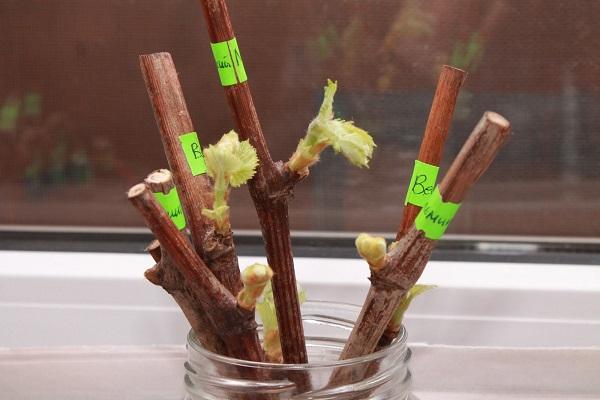
Layers
Reproduction by acceleration of layering is carried out according to the following rules:
- Layers are carried out at the end of September-October, after the leaves are dropped by the tree.
- The lower shoots are tightly buried.
- The roots appear after a year.
- After the roots appear, they are cut off and transplanted separately.
Seeds
The most difficult breeding method. Carry out as follows:
- The seeds are prepared in December or March.
- Prepare a deep container, flat in shape. Fall asleep in them with nutritious soil.
- Pour in water.
- Seeds are placed there.
- Cover from above with small pieces of bark or sand.
- The container is covered with glass or foil to create a greenhouse effect.
- Leave in a dark room for 2 weeks.
- After the emergence of seedlings, they are transferred to the windowsill.
- After the mouth grows stronger, it is transferred to the ground.

Use in landscape design
The tree is used for vertical gardening. It is often planted next to gazebos, terraces, pergola. She creates shade in gazebos, especially in hot weather. Wisteria is planted along fences. Due to the fact that the inflorescences are densely arranged, it forms a "living fence". Do not plant it next to flimsy wood structures, they will collapse under the weight of the branches.
